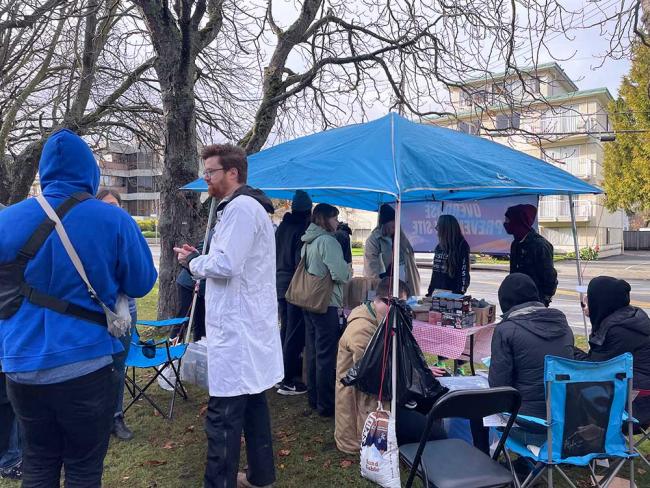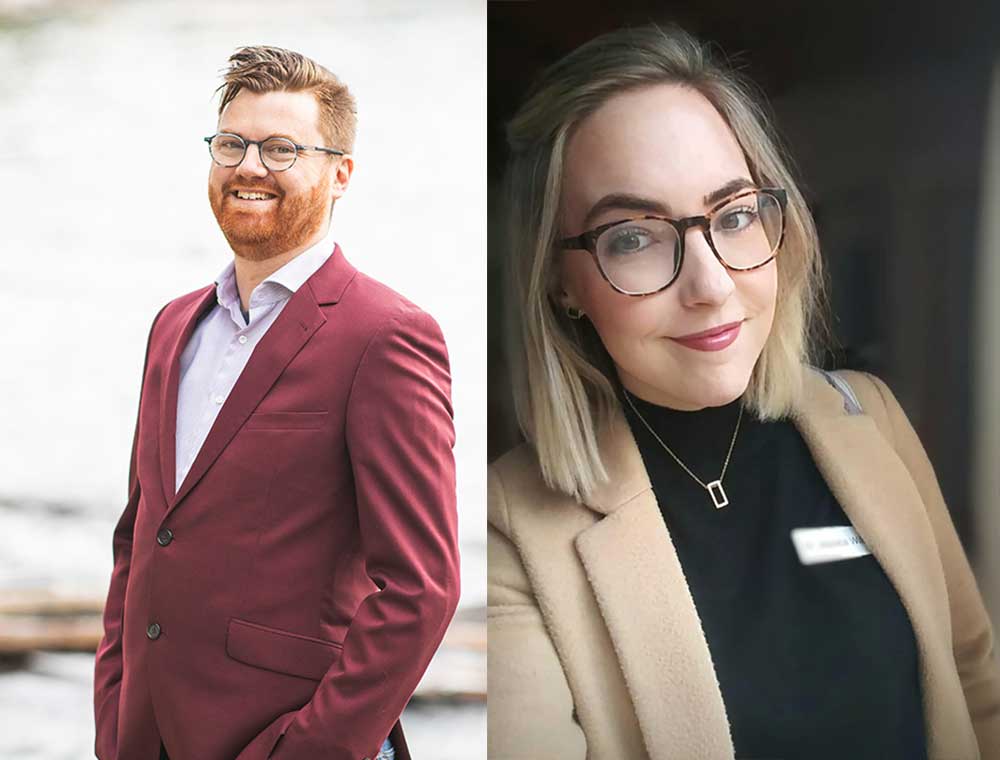Articles Menu

Nov. 18, 2024
Two temporary overdose prevention sites run by independent doctors and supported by harm reduction organizations have opened this week just outside Nanaimo Regional General Hospital and Royal Jubilee Hospital in Victoria.
The sites will be open from 10 a.m. to 6 p.m. from Nov. 18 to Nov. 22 and will be staffed with physicians and volunteers trained in overdose prevention. The sites will provide harm reduction supplies, such as sterile needles and alcohol swabs, connect patients with referrals to treatment and detox, and allow people to consume drugs while supervised by someone who can intervene if a person overdoses.
The sites will not provide illicit drugs.
The sites will be operating under the 2016 Order of the Minister of Health, which calls for overdose prevention sites to be set up “for the purpose of monitoring persons who are at risk of overdose, and providing rapid intervention as and when necessary… in any place there is a need for these services.”
More than 16,721 unregulated drug deaths have been recorded between January 2016 to September 2024 in the province, with annual deaths steadily climbing since 2016. Numbers for October have not yet been released.
“We’re currently in the middle of the biggest public health crisis that Canada has ever seen and we’re about to go into our ninth year of it,” Dr. Jess Wilder, a family and addictions medicine doctor in Nanaimo, told The Tyee. “As a physician I took an oath, which means I have to advocate for life-saving services when they’re needed and I have to provide those services for my patients whenever I can.”

The pop-up overdose prevention sites at Nanaimo Regional General Hospital and Royal Jubilee Hospital were conceptualized by Wilder and organized by Doctors for Safer Drug Policy, an independent group of physicians from across Vancouver Island who work with people who use substances, advocating for compassionate, inclusive and evidence-based care for all. They are being supported by harm reduction organizations including Moms Stop the Harm, the Nanaimo Area Network of Drug Users and the Harm Reduction Nurses Association. Around 60 people have volunteered their time to establish the pop-ups, Wilder said.
Between 25 to 50 patients at any given major hospital in B.C. will have a substance use disorder marked on their medical chart and could benefit from an overdose prevention site, Wilder said.
“We have, as practice community, noticed a stark increase in unwitnessed overdoses in hospital buildings or on hospital grounds resulting in code blues being called,” says Dr. Ryan Herriot, a family and addictions medicine doctor in Victoria who is volunteering at the pop-up sites. A code blue is a cardiac arrest.
Herriot says he hopes the pop-up sites will nudge the provincial government and health authorities to open their own permanent, publicly funded sites at major hospitals.
Confusion about supervised consumptions sites at hospitals
In April the Globe and Mail reported that Health Minister Adrian Dix had said all B.C. hospitals would be required to provide a supervised consumption site for patients with substance use disorders.
Shortly after the Globe and Mail’s article was published, the province clarified its stance by saying drug use in hospitals was not allowed and that police had the authority to forcibly remove someone from an area if they were caught using or possessing drugs.
If a hospital had an overdose prevention site an inpatient would only be allowed to access it if their doctor said they could as part of their care plan, the province said.
In November a Health Ministry spokesperson told The Tyee that Dix misspoke during that April press conference and that B.C. would not require overdose prevention sites at all hospitals.
Wilder expressed frustration with the shift in position between what Dix initially said at the press conference and the province’s assertion he’d misspoke.
The pop-up sites are being funded by the independent group of doctors who are paying out of pocket for supplies and taking time off work to help out, Herriot said.
The sites will be open for just one week because “there’s a limit to how much you can sustain something with no funds and volunteer labour,” Herriot said. The group is opening the sites to line up with “cheque week,” when welfare cheques are distributed and overdose rates spike, he added.
“Ultimately this should be a robust, publicly funded paid staff service,” Herriot said.
When The Tyee asked the Ministry of Health if overdose prevention sites would be built at hospitals it replied with an emailed statement that noted how a new overdose prevention site was opened at St. Paul’s in May 2024.
An overdose prevention site has been operating at St. Paul’s since May 2018, starting as a walled tent before moving to the hospital’s basement.
Illicit drugs being used unsupervised on hospital grounds
Reporting this spring from various outlets alleged that the province’s decriminalization policy had led to situations where nurses were walking through “toxic plumes of fentanyl” as they went about their work. Decriminalization did not allow drug use in hospitals but it did seem to create confusion around enforcement.
“When we first heard concerns about unintended, accidental exposure to illicit drugs in hospitals… we thought the direction was very straightforward,” Corey Ranger, president of the Harm Reduction Nurses Association, told The Tyee.
Ranger says the clear solution was to provide supervised consumption sites on hospital grounds, which would reduce the risk of harm and death caused by overdoses, reduce the risk of infections and disease transmission and promote the health and safety of patients and staff.
“Instead we saw this false dichotomy that we either keep people who use drugs safe or we keep nurses safe but we can’t do both. That is not accurate,” Ranger said.
Wilder told The Tyee that the evidence about interventions to save the lives of people who use drugs was clear, and the moral panic around the issue had simply led to people using drugs in the hospital in more secluded places, such as bathrooms.
“The patient doesn’t want to to have to be using in a bathroom,” Wilder said. “But when their alternative is being told they have to go and use off hospital grounds and hide in a bush or hide in the shadows and risk somebody not finding them, we aren’t leaving them with very many good options.”
The new NDP cabinet, including the health minister, will be announced today. Herriot said the doctors intended to give the health minister “their first job” by showing the public support for overdose prevention sites and calling for the government to establish sites at hospitals.
Building an outdoor overdose prevention site is very affordable, Ranger said, and the site in the St. Paul’s Hospital parking lot provides an example. All that is needed is naloxone, staff with lived and living experience who are trained in overdose response, good lighting and heat, he said.
“That’s really easy to do if you have the political will and courage to do what is right,” he added.
‘Fighting a forest fire with a water gun’
When patients are admitted to hospital with issues such as infections, or heart failure, they are removed from their regular dealer and other harm reduction practices or support networks, Wilder said.
Wilder said addiction medicine teams are “fighting a forest fire with a water gun” when trying to match what a patient’s body is addicted to using drugs that are available in hospitals.
If a patient is addicted to fentanyl and has been buying from the unregulated street supply, their bodies are accustomed to a potency that is stronger than anything that is available to be prescribed in hospital, Herriot said.
The contamination of the street supply means someone can additionally be addicted to benzodiazepines (depressants that can be prescribed medically to treat anxiety or seizures), xylazine (a tranquilizer used by veterinarians that is not approved for use in humans) or dexmedetomidine (a non-opioid based sedative) and not know it, Wilder said.
If a patient is addicted to benzodiazepines and the addiction medicine team is not able to figure out “the right recipe” to administer, they can have withdrawal seizures that cause injury due to a lack of oxygen to the brain or other medical complications, Wilder said.
Xylazine and dexmedetomidine sedate people and can also impact their breathing, she said.
“I had a mom message me the other day… whose son had an overdose and she was having to monitor him for the entire day and night because of the adulterants in his supply,” Wilder said. “She was afraid her son was going to die for an entire 24-hour period.”
Doctors will label a patient as being difficult or say because they are frequently off-site that they are not engaging in their care, Wilder said.
If drugs are found in a patient’s room they can be kicked out, Herriot added.
“When they decide to leave because they can no longer stand the intolerable suffering of their withdrawal symptoms we label them as being discharged against medical advice,” Wilder said.
“This is not them discharging against medical advice. This is them staying for as long as they can tolerate to try to receive care in a system that cannot meet their needs.”
This is a crisis that impacts everyone in B.C., Wilder said, with around one in three people directly affected either because of their own substance use or because they’ve lost someone dear to them.
“I think a lot of Tyee readers would be surprised to know how just how many of their friends and loved ones are my patients,” she said.
[Top photo: After Dr. Ryan Herriot, in the white coat, opened a pop-up overdose prevention site on Royal Jubilee Hospital grounds today, the site was moved off hospital grounds by hospital security teams to city property. Photo by Brishti Basu.]